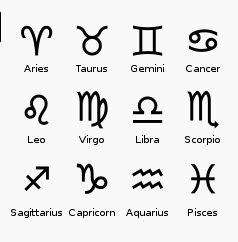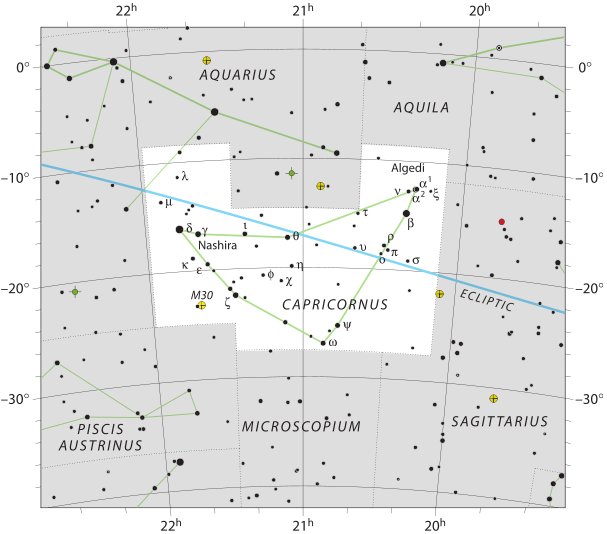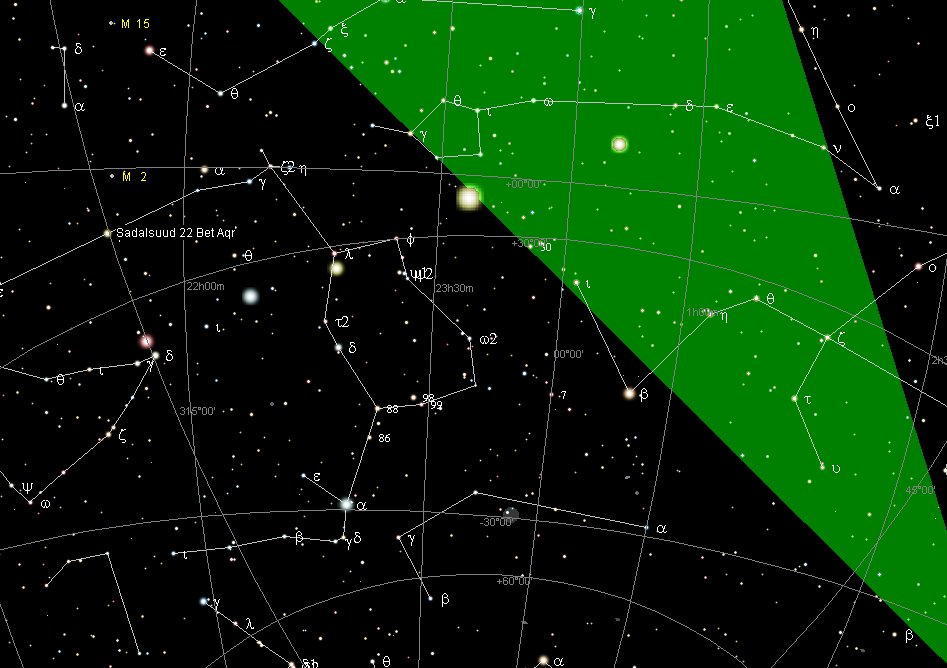58. The star named Outstretched
(Mebsuta, *100), at the contour of the Castor part of the figure, could imply that the Gemini
constellation was perceived as a pair of legs (belonging to a single
person):
A tiny star named Contracted (Mekbuda,
*105, ζ) was at the other
leg so to say, at MAY 1 (Beltaine),
with the Full Moon (its nakshatra place) at right ascension *105 + *183 = *288 (→
2 * 144 → 12 * 24 → 6 * 48 → 3 * 96).
... During his descent the ancestor still
possessed the quality of a water spirit, and his body,
though preserving its human appearance, owing to its being
that of a regenerated man, was equipped with four flexible
limbs like serpents after the pattern of the arms of the
Great Nummo. The ground was rapidly approaching. The
ancestor was still standing, his arms in front of him and
the hammer and anvil hanging across his limbs. The shock of
his final impact on the earth when he came to the end of the
rainbow, scattered in a cloud of dust the animals,
vegetables and men disposed on the steps. When calm was
restored, the smith was still on the roof, standing erect
facing towards the north, his tools still in the same
position. But in the shock of landing the hammer and the
anvil had broken his arms and legs at the level of elbows
and knees, which he did not have before. He thus acquired
the joints proper to the new human form, which was to spread
over the earth and to devote itself to toil
...

Thus the 'leg' corresponding to that of Pollux (→
Po as in the Italian river followed by Lux → Latin
for Light) would be out in the daylight at the beginning of summer with Castor at the end of
the winter nights.
Therefore we could guess an emblem for the Gemini 'person' should
be Π. Which indeed is not far away:

.jpg)
It is also worthy of noting that the 15th Chinese lunar
station was named Legs.

But we should now look at the current end of the Goat, at the
stars visible in
the evening of
March 14 (3-14)
AD 2024:


 |
 |
|
Gb1-26
(355
-
100) |
Gb2-1 (216
+ 40
= 256
→ 4
* 64) |
|
PLACE
OF
THE
SUN |
|
21h
(319.6)
→
137.0
+
365.25
/ 2
=
319.6
ARMUS
= η
Capricorni
(319.0),
DORSUM
= θ
Capricorni
(319.3),
TSOO
= 24
Capricorni
(319.7) |
DRAMASA =
σ
Oct.,
χ Capricorni
(320.0),
ν
Aquarii
(320.3),
γ
Equulei (320.6),
ο
Pavonis (320.8) |
|
Febr
3
(399) |
4 (400
-
365
= 35) |
|
°Jan
30
(*315) |
31 (396) |
|
'Jan
7
(*292) |
8 (373) |
|
CHRISTMAS
EVE
(*278) |
"Dec 25 (359) |
|
DEC
1
(355
-
20) |
2 (336
→ 4
* 84) |
|
... only at the
evening of the solstitial days can spirits enter heaven, the
inhabitants of the northern parts of the island at one solstice,
the dwellers in the south at the other ... |
|
THE NAKSHATRA
VIEW: |
|
9h
(137.0)
σ¹
Ursa
Majoris
(137.0),
κ
Cancri
(137.3),
τ
Cancri
(137.4),
ALSUHAIL
(al
Wazn,
of
the
Weight)
=
λ in
the
Vela
(Sail)
part
of
Argo
Navis
(137.5),
σ²
Ursa
Majoris
(137.6),
τ
Ursa
Majoris
(137.7),
ξ
Cancri
(137.8)
*96.0
=
*137.4
-
*41.4 |
κ
in
the
Pyxidis
(Mariner's
Compass) part
of Argo
Navis
(138.0),
ε
(138.5) |
|
Aug
5 |
6
(218
=
400
-
182) |
|
"June
25
(217
-
41) |
26
(177
= 6
*
29½)
|
|
JUNE
2
(153
=
176
-
23) |
3
(218
-
64) |
 |
 |
|
Ga3-13 |
Ga3-14
(73
=
256
-
183) |
 |
 |
 |
 |
|
Gb2-2 |
Gb2-3
(29) |
Gb2-4 |
Gb2-5
(260) |
|
PLACE
OF
THE
SUN |
|
α
Oct.
(321.5),
δ
Equulei
(321.7),
Φ
Capricorni
(321.8)
March
6 AD
2024
(65)
MARS |
KITALPHA
(Part
of a
Horse)
=
α
Equulei
(322.0),
ALDERAMIN
(The
Right
Arm)
=
α
Cephei
(322.9) |
DAI
= ι
Capricorni
(323.5),
β
Equulei
(323.8) |
γ
Pavonis
(324.1),
YAN
=
ζ
Capricorni
(324.6) |
|
Febr
5
(36) |
6 |
7
(403) |
8
(*324) |
|
°Febr
1 |
2 |
3
(399) |
4
(*320) |
|
'Jan
9 |
10
(*295) |
11 |
12
(377) |
|
"Dec
25
(*280) |
26 |
27 |
28
(363) |
|
DEC
3 |
4 |
5
(339) |
6
(*260) |
|
THE NAKSHATRA
VIEW: |
|
π
Cancri
(139.2),
MIAPLACIDUS
=
β
Carinae
(139.3),
TUREIS
(Little
Shield)
=
ι
Carinae
(139.8) |
No
star
listed
(140) |
θ
Pyxidis,
MARKAB
VELORUM
=
κ
Velorum
(141.5),
AL
MINHAR
AL
ASAD
(The
Nose
of
the
Lion)
= κ
Leonis
(141.6),
λ
Pyxidis
(141.9) |
Star-25
(Horse)
/
ANA-HEU-HEU-PO-5
(Pillar
where
debates
were
held)
ALPHARD
(The
Horse)
=
α
Hydrae
(142.3),
ω
Leonis
(142.6),
τ¹
Hydrae
(142.7) |
|
Aug
7 |
8
(220) |
9
(*141) |
10 |
|
"June
27 |
28 |
29
(*100) |
30 |
|
JUNE
4 |
5
(156) |
6
(*77) |
7 |
 |
 |
 |
 |
|
Ga3-16 |
Ga3-17 |
Ga3-18
(77) |
Ga3-19 |
... On February
9 the Chorti
Ah K'in,
'diviners',
begin the
agricultural
year. Both the
260-day cycle
and the solar
year are used in
setting dates
for religious
and agricultural
ceremonies,
especially when
those rituals
fall at the same
time in both
calendars.
The
ceremony begins
when the
diviners go to a
sacred spring
where they
choose five
stones with the
proper shape and
color. These
stones will mark
the five
positions of the
sacred cosmogram
created by the
ritual.
When the
stones are
brought back to
the ceremonial
house, two
diviners start
the ritual by
placing the
stones on a
table in a
careful pattern
that reproduces
the schematic of
the universe. At
the same time,
helpers under
the table
replace last
year's diagram
with the new
one.
They
believe that by
placing the
cosmic diagram
under the base
of God at the
center of the
world they
demonstrate that
God dominates
the universe.
The priests
place the stones
in a very
particular
order. First the
stone that
corresponds to
the sun in the
eastern, sunrise
position of
summer solstice
is set down;
then the stone
corresponding to
the western,
sunset position
of the same
solstice. This
is followed by
stones
representing the
western, sunset
position of the
winter solstice,
then its
eastern, sunrise
position.
Together these
four stones form
a square.
They
sit at the four
corners of the
square just as
we saw in the
Creation story
from the Classic
period and in
the Popol Vuh.
Finally, the
center stone is
placed to form
the ancient
five-point sign
modern
researchers
called the
quincunx
...
BUNDA
(Foundation) / KAKKAB
NAMMAΧ (Star of Mighty Destiny)
... β and ξ
also constituted the Persian lunar station
Bunda and the similar Coptic
Upuineuti, the Foundation; but β alone
marked the sieu Heu, Hiu, or
Hü, Void, anciently Ko, the
central one of the seven sieu which, taken
together, were known as Heung Wu, the
Black Warrior, in the northern quarter of
the sky. It is found in Hindu lists as
Kalpeny, of unknown signification. On
the Euphrates it was Kakkab Nammaχ,
the Star of Mighty Destiny, that may have
given origin to the title of the manzil [Al
Sa'd al Su'ud], as well as to the
astrologers' name for it - Fortuna
Fortunarum. Al Firuzabadi of Khorasan,
editor of Al Kāmūs, the great Arabic
dictionary of the 14th century, called some
of the smaller stars below this Al Au'ā,
the plural of Nau', a Star, but
without explanation, and they certainly are
inconspicious ...
|
 |
 |
 |
 |
 |
|
Gb2-6 (9 *
29) |
Gb2-7 |
Gb2-8 |
Gb2-9 (35) |
Gb2-10 (265) |
|
Al Sa'd al Su'ud-22 (Luckiest of the Lucky)
/
Emptiness-11 (Rat)
TSIN = 36 Capricorni
(325.2),
ALPHIRK (The Flock) =
β
Cephei
(325.7),
SADALSUD =
β
Aquarii,
ξ
Gruis (325.9) |
No star listed (326) |
CASTRA =
ε
Capricorni
(327.2),
BUNDA (Foundation) =
ξ
Aquarii
(327.5)
SIRIUS (α Canis Majoris |
Mahar sha hi-na
Shahū-26 (Western One in the Tail of the Goat)
NASHIRA
(Fortunate One) =
γ
Capricorni
(328.0),
ν
Oct. (328.3),
AZELFAFAGE (Tail of the Hen) =
π¹
Cygni,
κ
Capricorni (328.7) |
Arkat sha hi-na
Shahū-27 (Eastern One in the Tail of the Goat)
ENIF (The Nose) =
ε
Pegasi, ERAKIS =
μ
Cephei
(329.2),
46 CAPRICORNI, JIH (the Sun) =
κ
Pegasi
(329.3),
ι
Piscis Austrini (329.4),
λ Capricorni
(329.6),
ν
Cephei (329.7),
DENEB ALGIEDI
=
δ
Capricorni
(329.8)
*288.0 = *329.4 - *41.4
March
14
AD
2024
(Π)
MARS |
 |
|
Febr 9 (40) |
10 |
11 |
12 (408) |
13 (345 +
64) |
|
°Febr 5 (36) |
6 |
7 |
8 (*324) |
9 (40) |
|
'Jan 13 (378) |
14 |
15 (*300) |
16 |
17 |
|
"Dec 30 (364) |
31 |
"Jan 1 |
2 |
3 (368) |
|
DEC 7 (11 *
31 = 341) |
8 |
9 |
10 |
11 (345) |

|



.jpg)










